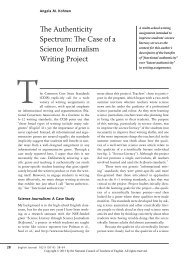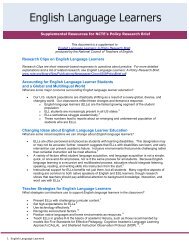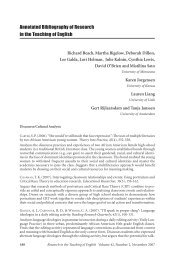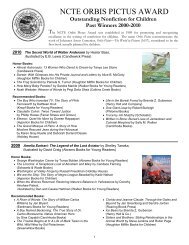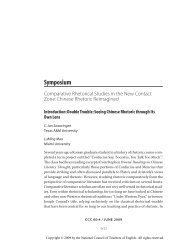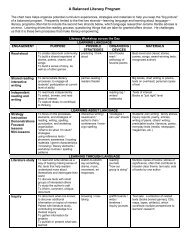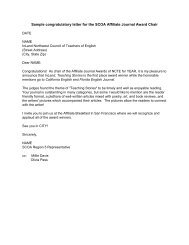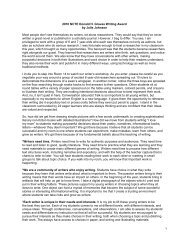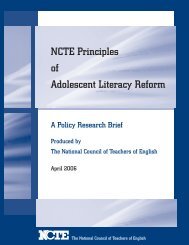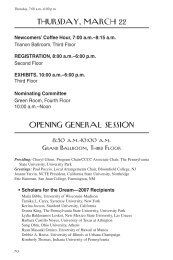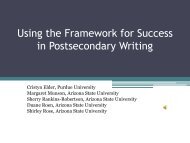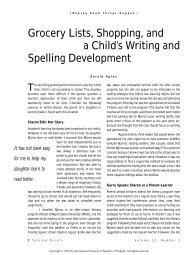A Cold Manipulation of Language - National Council of Teachers of ...
A Cold Manipulation of Language - National Council of Teachers of ...
A Cold Manipulation of Language - National Council of Teachers of ...
Create successful ePaper yourself
Turn your PDF publications into a flip-book with our unique Google optimized e-Paper software.
Melissa W. Noel<br />
A <strong>Cold</strong> <strong>Manipulation</strong><br />
<strong>of</strong> <strong>Language</strong><br />
English language fascinates and inspires<br />
some <strong>of</strong> us. Through close examination<br />
we learn about the subtle<br />
changes and nuances <strong>of</strong> language—<br />
those alterations that authors make to elicit a compelling<br />
response from a reader throughout a lengthy<br />
text, say, a book or novel. Sophisticated readers recognize<br />
the tone shifts, the waves <strong>of</strong> emotions, the<br />
power <strong>of</strong> the language. Some students, however, see<br />
a monotone, flat line similar to an EKG <strong>of</strong> a corpse.<br />
Textbooks and grammar worksheets do not adequately<br />
convey to students how readers or listeners<br />
are shaped by the language <strong>of</strong> the writer. The best<br />
way to help students understand the emphasis <strong>of</strong> a<br />
dash or another device is to see one used during a<br />
suspenseful moment in a dramatic selection. It is up<br />
to the teacher to select dramatic works that generate<br />
internal conflicts for students, because those literary<br />
selections will make them sit up and pay attention to<br />
the language that is in front <strong>of</strong> them. Once they are<br />
aware <strong>of</strong> their physical responses, most readers will<br />
note the language and yearn to figure out the ultimate<br />
question: “How did the author do that?”<br />
A useful text to illustrate that authors control<br />
language for an audience is In <strong>Cold</strong> Blood by Truman<br />
Capote, so I always start my AP English <strong>Language</strong><br />
and Composition course with that text.<br />
Activities that teach tone, diction, and syntax are<br />
used throughout my Capote unit to help the students<br />
understand and master concepts that might<br />
be poorly understood. I introduce the Aristotelian<br />
model <strong>of</strong> rhetoric (audience—subject—speaker)<br />
with this book, as Capote carries the students<br />
through his real (or invented) personal saga with<br />
A high school teacher<br />
shows how close<br />
examination <strong>of</strong> the<br />
language in Truman<br />
Capote’s In <strong>Cold</strong> Blood<br />
can help students develop<br />
greater awareness <strong>of</strong><br />
authors’ intentions and<br />
how writers use their<br />
language choices to<br />
influence readers.<br />
Perry Smith and Dick Hickock. Students appreciate<br />
the complications that In <strong>Cold</strong> Blood presents,<br />
and they enjoy examining the language that Capote<br />
uses to change readers’ perceptions <strong>of</strong> the events as<br />
he takes them through an account <strong>of</strong> the true story.<br />
One thing is always guaranteed during this unit: no<br />
one falls asleep!<br />
Teaching Nonfiction and In <strong>Cold</strong> Blood<br />
With nonfiction, especially imaginative nonfiction,<br />
such as Capote’s In <strong>Cold</strong> Blood, the question <strong>of</strong><br />
“What is the author’s purpose?” can be challenging.<br />
Maybe there is a global or local message to convey<br />
as in Fast Food Nation. Perhaps the author wants to<br />
prompt an action or generate a movement such as<br />
Booker T. Washington’s Up from Slavery. Or, as in<br />
Capote’s case, perhaps the writer has so many agendas<br />
that the discussion <strong>of</strong> intentions is endless.<br />
Truman Capote wanted to break away from<br />
fiction to awaken the world to a new genre by melding<br />
imaginative writing with journalistic reporting,<br />
so he wrote a nonfiction book—with a little<br />
flair. With his friend Harper Lee, he investigated<br />
the true account <strong>of</strong> the murder <strong>of</strong> Herbert Clutter’s<br />
family in Holcomb, Kansas, in 1959. Capote befriended<br />
the family, friends, and killers <strong>of</strong> the Clutter<br />
family to tell this horrific story. He presents the<br />
events chronologically with his “unnamed narrator”<br />
revealing everything from a “detached” viewpoint;<br />
however, it becomes apparent in Part II that the<br />
killers, or “Persons Unknown,” are shown some<br />
sympathy by the author. Frequently he presents one<br />
murderer, Perry Smith, as a victim instead <strong>of</strong> a<br />
50 English Journal 100.4 (2011): 50–54
Melissa W. Noel<br />
killer. The murder is quickly detailed in Part I and<br />
forgotten as the killers are described and followed<br />
on their trek across the country in a failed attempt<br />
to escape capture. The author gradually shows<br />
Smith’s handicaps and then begins detailing his<br />
past; before readers realize what is happening, they<br />
find themselves feeling some sympathy for this cold<br />
killer. Capote’s manipulation is gradual, but every<br />
reader recognizes it by the time he reaches Part II.<br />
I do not warn students that this shift in perspective<br />
is coming. In fact, I enjoy watching them<br />
discover it on their own, because it is the best example<br />
I know <strong>of</strong> an author’s deliberate manipulation<br />
<strong>of</strong> an audience. When students realize that<br />
Capote is showing kindness toward Smith, they are<br />
surprised, just as everyone else was when the book<br />
was released after Smith’s and Hickock’s executions.<br />
Without any encouragement from me, students<br />
ask, “Why did Capote do this? He just<br />
showed us the details <strong>of</strong> the murders in Part I.”<br />
That curiosity is a springboard for a discussion into<br />
HOW? How did Capote manipulate the reader to<br />
feel kindness toward Smith? This natural progression<br />
<strong>of</strong> curiosity—thanks to Capote—provides me<br />
an opportunity to show students how language can<br />
be controlled for a specific purpose.<br />
Lessons to Get There<br />
Through questioning and Socratic seminars, students<br />
arrive at the conclusion that Capote feels<br />
sorry for Smith because he connects to him on some<br />
level. In Chapter 1, Capote’s presentation is a good<br />
example <strong>of</strong> an author who starts by carrying readers<br />
down one path (presenting the Clutters as an ordinary<br />
country family before and during a horrible<br />
death) only to reroute the reader to a different path<br />
(presenting one killer as a benign, abused boy-like<br />
man with mental and physical handicaps). Capote<br />
leaves Dick Hickock, a cruel brute, out there to<br />
take the fall for the murders, only to shock the<br />
reader later (spoiler alert) with the revelation that it<br />
was Perry, the child-man for whom we felt some<br />
sympathy and understanding, who murdered the<br />
Clutters “in cold blood.” When students are put in<br />
a circle and asked to discuss the events <strong>of</strong> the story<br />
in a Socratic style, they arrive at some <strong>of</strong> these conclusions<br />
without my aid, and those conclusions are<br />
more powerful than a worksheet or lecture.<br />
Capote’s ultimate purposes for writing In <strong>Cold</strong><br />
Blood can be discussed for days. What was Capote’s<br />
true purpose in presenting Smith as a damaged<br />
child? Did he connect to Smith and feel sympathy<br />
for him? Did Capote want to toy with an audience,<br />
or was he presenting his real conflicted feelings?<br />
Did Capote want to create a new genre?<br />
Students <strong>of</strong>ten argue that Capote wants readers<br />
to understand Smith. Some will research and<br />
support the notion that he<br />
felt romantically attached<br />
to Perry Smith. Claims<br />
such as these must be<br />
proven through evidence in<br />
the text, and that takes a<br />
lot <strong>of</strong> work on the student’s<br />
part. The ending <strong>of</strong> the<br />
book suggests another purpose<br />
as the narrator attends<br />
the execution and blatantly<br />
opposes the action to make<br />
When students realize<br />
that Capote is showing<br />
kindness toward Smith,<br />
they are surprised, just as<br />
everyone else was when<br />
the book was released<br />
after Smith’s and Hickock’s<br />
executions.<br />
a clear political statement against the death penalty.<br />
By the time my students reach the end <strong>of</strong> the<br />
book, everyone agrees that Capote had an agenda<br />
far beyond detailing the events <strong>of</strong> a murder in Holcomb,<br />
Kansas. Of that, we can be certain.<br />
While reading the book, I incorporate lessons<br />
to highlight tone, diction, syntax, attitude, and<br />
style to explain rhetoric since these are the tools<br />
that create the manipulation <strong>of</strong> language (see examples<br />
in the next section). My primary objective is<br />
to teach my audience how these fundamental devices<br />
can enable them, as writers, to have a desired<br />
effect on their own audiences. Students need to understand<br />
audience and what their readers demand,<br />
but they also need to understand how diction and<br />
syntax can alter the tone <strong>of</strong> a paragraph; I also want<br />
them to recognize that the tone can shift and change<br />
throughout a selection—just as it does in In <strong>Cold</strong><br />
Blood.<br />
Since In <strong>Cold</strong> Blood walks the line between fiction<br />
and nonfiction, it makes an excellent study for<br />
a class that wants to discuss “purpose” and “audience,”<br />
as the author deliberately takes readers where<br />
Capote wants them to go—into the mind <strong>of</strong> Perry<br />
Smith, a man that he possibly cared for more than<br />
we want to know about. He confuses readers as he<br />
relates affection for Smith, aversion to Hickock,<br />
and indifference for the family. This makes the<br />
English Journal<br />
51
A <strong>Cold</strong> <strong>Manipulation</strong> <strong>of</strong> <strong>Language</strong><br />
students ask, without prompting, “What is this author<br />
doing?” They read along with the text and recognize<br />
the nuances <strong>of</strong> the language while examining<br />
the passages. Capote said in an interview in the New<br />
York Times, “in the nonfiction novel [one] can also<br />
manipulate: if I put something in which I don’t<br />
agree about I can always set it in a context <strong>of</strong> qualification<br />
without having to step into the story myself<br />
to set the reader straight” (qtd. in Plimpton).<br />
My class can follow the chronology <strong>of</strong> the events<br />
and the way the tone shifts to trace how the “narrator”<br />
changes his opinions about the people involved<br />
in the case as he continues his investigation. This<br />
shift is obvious in the tone and style <strong>of</strong> Capote’s<br />
writing. The study <strong>of</strong> this book enables a class to<br />
examine an author’s use <strong>of</strong> language—not only so<br />
the students can understand his methods, but so<br />
they can understand the power <strong>of</strong> these tools for<br />
their own writing. Students practice writing passages<br />
in which they alter the tone for a specific audience<br />
and shift that tone within a single work.<br />
Finally, they start to recognize the depth <strong>of</strong> language<br />
a little bit more.<br />
Highlighting Authorial Choices<br />
First published in 1956, one <strong>of</strong> Capote’s short stories,<br />
“A Christmas Memory,” serves as a nice comparison/contrast<br />
piece for In <strong>Cold</strong> Blood when<br />
analyzing tone as a rhetorical device (see fig. 1). At<br />
least part <strong>of</strong> Capote’s intent with his descriptions is<br />
to create verisimilitude that<br />
The study <strong>of</strong> this<br />
book enables a class<br />
to examine an author’s<br />
use <strong>of</strong> language—not<br />
only so the students<br />
can understand his<br />
methods, but so they<br />
can understand the<br />
power <strong>of</strong> these tools<br />
for their own writing.<br />
encourages readers to visualize<br />
the characters. In his fiction<br />
and in In <strong>Cold</strong> Blood, he details<br />
the people he wanted the readers<br />
to see. However, the paragraph<br />
about the eccentric old<br />
aunt in “A Christmas Memory”<br />
is different from the description<br />
<strong>of</strong> Herbert Clutter in<br />
the more journalistic account<br />
(however blighted) <strong>of</strong> In <strong>Cold</strong><br />
Blood. Both are vivid portrayals,<br />
but the description <strong>of</strong><br />
Figure 1. Comparing Capote’s Writing Styles<br />
Excerpt from Capote’s “A Christmas Memory”:<br />
A woman with shorn white hair is standing at the<br />
kitchen window. She is wearing tennis shoes and a<br />
shapeless gray sweater over a summery calico dress.<br />
She is small and sprightly, like a bantam hen; but,<br />
due to a long youthful illness, her shoulders are pitifully<br />
hunched. Her face is remarkable—not unlike<br />
Lincoln’s, craggy like that, and tinted by sun and<br />
wind; but it is delicate too, finely boned, and her<br />
eyes are sherry-colored and timid. “Oh my,” she<br />
exclaims, her breath smoking the windowpane, “it’s<br />
fruitcake weather!”(n.p.)<br />
A description <strong>of</strong> Herbert Clutter from In <strong>Cold</strong> Blood:<br />
As an educated man successful in his pr<strong>of</strong>ession, as<br />
an eminent Republican and church leader—even<br />
though <strong>of</strong> the Methodist church—Mr. Clutter was<br />
entitled to rank among the local patricians, but just<br />
as he had never joined the Garden City Country<br />
Club, he had never sought to associate with the<br />
reigning coterie. Quite the contrary, for their pleasures<br />
were not his; he had no use for card games,<br />
golf, cocktails, or buffet suppers served at ten—or,<br />
indeed, for any pastime that he felt did not “accomplish<br />
something.” (34)<br />
Buddy’s aunt includes more adjectives and different<br />
syntax. Inserted commas for the aunt allow the author<br />
to add more color; the dashes in the second selection<br />
from In <strong>Cold</strong> Blood allow him to add more<br />
details. “Decisions about formal and informal language,<br />
the use <strong>of</strong> narrative or quotations, the tone <strong>of</strong><br />
familiarity or objectivity” are important aspects <strong>of</strong><br />
rhetoric that go beyond lessons on grammar (Roskelly<br />
9). The students get to observe how a writer<br />
uses punctuation correctly as a tool to change the<br />
tone. After looking at the punctuation, the class can<br />
examine the diction, syntax, and tone, all leading to<br />
the author’s purpose for each piece <strong>of</strong> literature.<br />
Comparing and contrasting samples <strong>of</strong> In<br />
<strong>Cold</strong> Blood to other works by Capote helps students<br />
see how his intentions vary as he switches from fiction<br />
to nonfiction. The style <strong>of</strong> both varies just<br />
enough to generate a good discussion about tone<br />
and attitude because the short story is more saccharine<br />
than anything in In <strong>Cold</strong> Blood, except, perhaps,<br />
the description <strong>of</strong> Nancy Clutter. The voice is<br />
far more detached in the second selection, and the<br />
diction is less expressive. The syntax, too, is less<br />
complex. The clauses differ enough to generate discussion.<br />
Students are able to deduce the reasons behind<br />
the differences for these authorial strategies.<br />
Since Truman Capote wrote Breakfast at Tiffany’s<br />
and In <strong>Cold</strong> Blood, it is also a useful selection<br />
for showing students how one author can narrate in<br />
a different voice. Students can compare selections <strong>of</strong><br />
52 March 2011
Melissa W. Noel<br />
the novella to In <strong>Cold</strong> Blood to examine the differences<br />
in the author’s writing style. A teacher could<br />
also show sections <strong>of</strong> the Audrey Hepburn movie,<br />
Breakfast at Tiffany’s, to compare the tone <strong>of</strong> the romantic<br />
movie to Capote’s story, which is far darker<br />
than the film. However, that takes up more class<br />
time than the lesson involving “A Christmas Memory.”<br />
Capote’s Breakfast at Tiffany’s has a completely<br />
different quality and nature, however, and provides<br />
good discussion regarding purpose, audience, and<br />
intent.<br />
Examining Pathos<br />
Once students start to see a definite preference in<br />
Capote for Smith, a good activity to discuss pathos,<br />
or appeals to emotion, is a comparison <strong>of</strong> Smith and<br />
Hickock, the two murderers. I typically discuss the<br />
details that are included about Smith—his sister’s<br />
letter, his father’s interview, etc.—and how that in-<br />
formation is used to convey that Smith was an<br />
abused, ignored child with little hope or intelligence.<br />
Readers quickly infer that Smith suffers from<br />
some form <strong>of</strong> mental illness as the narrator includes<br />
dreams about a bird that visits Smith. Information<br />
about Hickock is scarce in comparison. These included<br />
details illustrate a lot because “[w]hen writers<br />
draw on the emotions and interests <strong>of</strong> readers,<br />
and highlight them, they use pathos, the most powerful<br />
appeal” (Roskelly 10; italics in original). The<br />
lack <strong>of</strong> details regarding Hickock speaks just as<br />
loudly, if students are encouraged to notice it. I ask<br />
students to keep a chart <strong>of</strong> information for both killers<br />
in the middle <strong>of</strong> Part II (see fig. 2). It does not<br />
take long for them to see Capote’s inequitable treatment<br />
<strong>of</strong> them, and then the students can discuss<br />
what that means. Once Capote’s favoritism <strong>of</strong> Perry<br />
is noted, students can pull paragraphs to analyze<br />
tone, syntax, and diction to find more examples <strong>of</strong><br />
partiality.<br />
Figure 2. In <strong>Cold</strong> Blood<br />
Name _____________________<br />
Part II: Persons Unknown<br />
Directions: Use this chart to record the stylistic differences in Capote’s writing as he describes Dick Hickock and Perry<br />
Smith in Part II. In each column, provide textual evidence <strong>of</strong> these distinctions, note the stylistic device used, and write<br />
any thoughts you have about these notes. At the bottom, please summarize your annotations and draw a conclusion<br />
about Capote’s purpose in his presentation <strong>of</strong> these men. Stylistic devices to look for include details, tone, figurative<br />
language, diction, and syntax. I have provided two examples. Please write down the page number next to the quote.<br />
Stylistic Device Dick Hickock Stylistic Device Perry Smith<br />
Detail<br />
Syntax—use <strong>of</strong> dashes<br />
and italicized word<br />
Perry says, “Dick, if he<br />
knew Dick, and he did—<br />
now he did—would<br />
spend it right away on<br />
vodka and women”<br />
(119).<br />
This detail presents Dick<br />
as a womanizer and a<br />
drunk. The syntax<br />
(dashes/italics) shows<br />
Perry as being wise and<br />
superior. He’s more likable<br />
than Dick.<br />
Detail<br />
Figurative <strong>Language</strong>—<br />
strong adjectives<br />
Syntax—dramatic pause<br />
with “as though at last,”<br />
almost wistful<br />
Otto’s drawings <strong>of</strong> Perry:<br />
“Perry’s expression, his<br />
look <strong>of</strong> unflawed fulfillment,<br />
<strong>of</strong> beatitude, as<br />
though at last, and as in<br />
one <strong>of</strong> his dreams, a tall<br />
yellow bird had hauled<br />
him to heaven” (120).<br />
In this entire chapter,<br />
Otto draws portraits <strong>of</strong><br />
Perry. Does that mean<br />
that he’s worthy <strong>of</strong> being<br />
drawn? Is he overtly<br />
attractive, or somehow<br />
precious?<br />
Add more columns<br />
Summary <strong>of</strong> observations: (What did you notice?)<br />
Conclusion <strong>of</strong> observations: (What do you think accounts for the differences?)<br />
English Journal<br />
53
A <strong>Cold</strong> <strong>Manipulation</strong> <strong>of</strong> <strong>Language</strong><br />
The Value<br />
Through these lessons students recognize how to<br />
engage with a text and question an author by recognizing<br />
that writers have agendas other than making<br />
money or getting published. The primary objective<br />
for me is to teach my readers and writers the command<br />
<strong>of</strong> voice. I want students to understand how<br />
it can empower their writing; likewise, students<br />
must understand how uncontrolled voice can hinder<br />
what writers are trying to communicate. Capote<br />
was castigated for his attempts at making a martyr<br />
out <strong>of</strong> Smith when he was obviously a brutal killer<br />
<strong>of</strong> an innocent family that lived on the plains <strong>of</strong><br />
Kansas. This result is a reminder <strong>of</strong> the power <strong>of</strong><br />
rhetoric. Students must learn to question writers.<br />
The final job is for students to learn how to manipulate<br />
their rhetorical devices for their own purposes.<br />
But that, I dare say, is another lesson.<br />
Works Cited<br />
Capote, Truman. “A Christmas Memory.” Short Story<br />
Classics. 8 Feb. 2004. Web. 12 July 2010. .<br />
———. In <strong>Cold</strong> Blood. New York: Random, 1965. Print.<br />
Plimpton, George. “The Story behind a Nonfiction Novel.”<br />
New York Times. 16 Jan. 1966. Web. 12 Jan. 2010.<br />
.<br />
Roskelly, Hepzibah. “What Do Students Need to Know<br />
about Rhetoric?” AP English <strong>Language</strong> and Composition.<br />
The College Board, 2008. Web. 23 Oct. 2010.<br />
.<br />
Melissa W. Noel holds a bachelor’s in English from the College <strong>of</strong> Charleston and an MAT in Educational Technology from<br />
Webster University. An English teacher at Cleveland High School, Melissa is an experienced AP English <strong>Language</strong> and Composition<br />
instructor and reader for CollegeBoard. She has also taught a dual enrollment writing course for the University <strong>of</strong> Missouri–<br />
St. Louis. She resides and teaches in Clayton, North Carolina. She may be reached at melissanoel@johnston.k12.nc.us.<br />
READWRITETHINK CONNECTION<br />
Lisa Storm Fink, RWT<br />
See the lesson plan “What’s the Purpose?: Examining a <strong>Cold</strong> <strong>Manipulation</strong> <strong>of</strong> <strong>Language</strong>,” which is based on the<br />
above article and written by the same author. http://www.readwritethink.org/classroom-resources/lesson-plans/<br />
what-purpose-examining-cold-30653.html<br />
Dog Moon Turkey<br />
The thick gristle <strong>of</strong> the wing bone <strong>of</strong><br />
the wild turkey lifting its gaggle <strong>of</strong>f<br />
the ground, the dog in a hopeful ecstasy<br />
<strong>of</strong> chase.<br />
That’s what I’d arrange to be<br />
tomorrow if tomorrow were to choose<br />
me as target.<br />
A spill <strong>of</strong> bluets<br />
on the grass now, dropped last night by a moon<br />
carrying more milk than its bucket holds.<br />
The turkey thinks it’s beautiful. The moon<br />
plays Jackson Pollock on the grass.<br />
The dog chases what it knows it can’t catch.<br />
—Roger Mitchell<br />
© 2011 Roger Mitchell<br />
Roger Mitchell lives and writes near the Canadian border in Jay, New York. His most recent book is The One Good Bite in<br />
the Saw-Grass Plant. Email him at mitchelr@indiana.edu.<br />
54 March 2011



